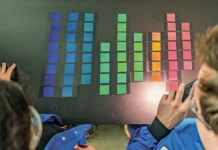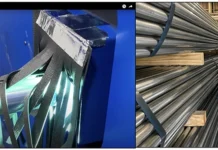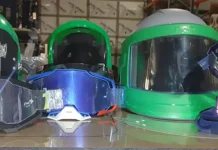By Dene Taylor, Ph.D., and Vince Cahill, SPF-Inc.
Inkjet printing using energy-cure (EC) inks is expanding rapidly through the graphic arts and industrial printing markets. Printers in use number in the 10,000s, built by more than 40 graphic arts printer OEMs and at least 100 integrators for other industries. More than 40 companies manufacture UV-cure inkjet ink – about half in North America – and several are nurturing EB as well. Ink distribution is worldwide. Annual ink consumption is measured in thousands of tons, with many more than a thousand devices using ink supplied in gallon bottles or 5-gallon pails. Growth is double-digit and is projected to stay at that rate for some years.
Discussion
Markets for UV ink include:
- graphic arts and commercial printing for billboards, banners, displays, advertising and more;
- labels for retail, industrial and commercial products;
- 3D or additive manufacturing for models and prototypes;
- industrial printing, such as flooring, laminate, furniture, wall coverings, decoration, equipment instructions and road signs;
- packaging, especially corrugated cardboard, folding carton and some flexible packaging; and
- marking and coding, which includes barcodes and serial numbers, etc., on packages and products.
Drivers for digital printing
The advantages of digital print are the same for new markets as they have been for mature markets. They include:
- minimal cost and time to change products;
- ability to print on demand and slash inventories;
- ability to print the exact number needed, not an excess;
- economical short runs; and
- support for regional selling.
EC inkjet also is durable, immediately dry, has bright colors and – of great value for industrial applications – is noncontact.
Of equal importance to the owner is that equipment cost is modest for the margin delivered, so loans can be paid off well ahead of schedule. And, the typical small footprint of the machine often avoids facility expansion.
Printing technology
The core elements of the inkjet technology are well proven, reliable and becoming more cost-effective. It has maturity, but it is not stagnant – continuous incremental improvement is being made to the printheads, which increases reliability, reduces ink consumption and allows steadily faster operating speeds.
It has been the ability to assemble printheads in long arrays spanning the product that has been instrumental in opening the industrial printing market. That is the result of improvements in many areas – design, materials selection, manufacturing methodology, fluid handling and ink quality. But, getting the experience has required markets, the first of which were with aqueous and solvent inks for commercial and ceramic printing. Having a stationary print head with substrate moving continuously made possible the replacement of analog inline printers. And, the growth of the components business – printheads, ink handling, printer management hardware and software – has enabled the traditional OEMs in many industries to assemble or integrate their own inkjet systems. This addresses major weaknesses of the traditional digital printing OEMs – inexperience with materials handling and expertise with the applications. Their developments integrate seamlessly into major production lines, taking the substrate from the preceding process and passing it on in a fit state for the next and all subsequent unit operations.
Curing
Mercury UV lamps dominate the installed base and are still popular when equipment is being replicated. However, UV LED is now very popular and is preferred (unless it does not perform) because of its long life, consistent output and lower energy use. Obviously, LED also enables UV printing on temperature-sensitive substrates. It is exciting that EB cure for inkjet is a reality. It will be adopted first by the same people who use EB now – say, for offset printing – and for the same reasons. Installation announcements are anticipated around the time of publication of this article, but there are other applications in which it should be superior, and we look forward to enabling them.
Market sector activity
Inks for graphic arts. This market has a limited design base, as there are only a few machine configurations, a modest number of substrates – most with surfaces inherently suitable for or modified for the ink – and the various end-use requirements are well known. Although numbers of OEMs are increasing, many cover the full market for UV inks, and all ship machines that are ready-to-print and install quickly.
In the early days of UV, few inks were compatible, so a change required emptying and flushing the complete system. This was laborious, time-consuming and wasteful. Additionally, the OEMs did not want to carry any more inks than necessary: Many had shelf lives of less than a year. So, instead of producing a separate variant when an ink did not perform well – the practice with screen and flexography, for example – the capability of a formulation was expanded. This has been so successful that only about three variants are needed for the majority of graphic arts production. Formulating knowledge has spread, so producing good ink now is comparatively straightforward and less of an art.
Growth rates in graphic arts remain in double digits. Competition from third parties is increasing so, although volume is going up, margins are getting tighter, and prices are coming down. Nevertheless, the OEMs have retained a substantial market share.
The major change in ink has been to allow LED cure, preferably without inerting. We are watching emulsion UV-cure inks. They promise greater economy but need drying to remove the water. And, they necessarily contain surfactants, so are not yet much outside this sector.
Inks for labels. This market sector is seeing continued strong growth, with most label printing companies now offering digital print and – for the larger companies – UV cure. The ink channel is dominated by the OEMs and OEM ink manufacturers, with only a few third-party manufacturers being sufficiently trusted. Hence, pressure on prices is modest. The ink design base is again quite small: a limited number of substrates, a small number of printhead sources, a narrow range of applications and fewer than a dozen OEMs in control. UV inks easily meet the durability requirements, except for the most demanding long-term exposures. The primary driver for formulation change is demand for low-migration inks for food packaging. Cure solely by electron beam is the ideal anti-migration approach, as photoinitiators are the primary source of mobile species, directly or from incomplete monomer trapping. (A combination of UV sufficient to raise ink viscosity – called pinning in the digital world – to avoid bleed at the next colors, ending with purely EB clearcoat has been a vision we have not just for labels, but for part decorating.) EB curing for labels (and folding cartons) has been demonstrated (e.g., DRUPA 2016).
Inks for industrial applications. This sector is distinctly different from most others where digital printing has taken hold. There are dozens, if not hundreds, of applications: furniture, flooring, paneling, dashboards, gauges, equipment, logos, component decoration, instructions, plastics decorating, elastic materials and more. A great deal of print is for parts rather than panels or roll stock, so material handling is core. Substrates are of any and all plastics, wood and wood composites, papers, textiles, metals, alloys, leather and so on. They can be exposed in every environment, at all seasons, everywhere around the world.
Industrial printers are usually in a manufacturing line: a series of process steps. The printer must take the material from the preceding step, print it and pass it to the next process without delay or impediment. It should not be the rate-determining step. As mentioned above, the availability of inkjet technology components or complete print engines has enabled the production line vendors to have their own assemblies that they will integrate into the total production system.
The combinations of application, substrate and process mean nearly every job is distinct. An additional challenge for the formulator is that, unlike graphics and label printing, there are no other variables: Parts are predetermined, the substrate is chosen, the speed is set and there is no latitude with the performance. However, the cost or risk of changing ink supply is high, so business – once earned by the ink vendor – is usually retained.
The prognosis for electron beam in this sector is mixed. But, we are seeing applications where cure-through variable thickness (to a millimeter or more) is necessary and, when residues from photoinitiators prevent requirements being met, electron beam is the only viable cure method. Being high-volume industrial, the capital cost that is usually seen as prohibitive is easily amortized.
Inks for packaging. Digital printing has entered packaging for applications where the traditional digital OEM machines, whether toner or inkjet, have been functional. These are where there are limited substrate ranges, limited ink options and limited end-use environments. So, large UV inkjet flatbed presses are used for cardboard boxes, while label and commercial roll-to-roll printers have application with folding cartons. What would appear to be an excellent opportunity is flexible packaging (plastic bags and pouches). However, food packaging is the leading sector, and the others follow. And, as food packaging is highly regulated – with a very high penalty from demonstrated or perceived contamination from unbound ink component migration – only a small volume of UV ink is being used. Progress is being made from the determined efforts of committed chemical vendors and ink companies able to afford the development and testing effort. As with label printing, EB inkjet will be well poised here, as there are decades of successful compliance with offset printing and over-coating in the food packaging market by the leading ink vendors with inkjet.
Packaging offers dozens of applications for cartons, boxes, bags, cans, bottles and pouches. Surfaces are flat or curved, and there are many opportunities away from food. The range of substrates is extensive: a few metals, most plastics and paper, whether cellulosic or synthetic. Durability demands are modest or low. Cans and bottles have exterior exposure, outdoor and all seasons. Paper-based packaging, of course, is less demanding, but most have freezer-to-oven expectations. As much of the market is retail, print image appearance has high value.
3D and additive manufacturing. This is a relatively small volume but very high value market and good business for those in it. It has required distinctly different formulating, as the inks must substitute for solid polymers produced by extrusion molding, for example. OEMs control the ink channel and have limited the opportunities for entry by third-party formulators. Third parties have traditionally been the most innovative, so access to printers is critical for the expansion of the technology after this first easy boom. The installed base now is aging sufficiently for there to be machines available. It is to be hoped that the OEMs are not so short-sighted that they totally lock out the innovators for the next generation.
Opportunities
Energy cure ink for inkjet is a high-growth market: Rising tides lift all boats. Electron beam cure will ensure penetration of the near food markets packaging and counteract the migration perception of UV, with the opportunity for large inroads into flexible packaging. The industrial market also has large potential. In many instances, new installations will be based on digital inkjet printers and not analog, as the technology is sufficiently mature to be highly reliable. Similarly, there are applications where not only will EB be the best cure mechanism – it also can be easily afforded. Nevertheless, industrial inks are at least semi-custom – if not unique. Application know-how is particularly valued, but providing the balance for the complete production system while meeting or bettering end-use expectations is, as always, best.
Shortly after World War II, Dene Taylor was found under a cabbage on a dairy farm in New Zealand. He continued his affinity for dirt through his education, gaining a PhD in clay chemistry at the University of Waikato in 1977, and a post-doctoral fellowship on sewage-soil chemistry with Albany Medical College and NYS Dept. Health. In his industrial career, he led development of specialty papers and films for analog and digital printing, using EB cure first in 1988, and UV cure from 1989. He joined RadTech shortly thereafter. In 2000, he formed the technical consultancy Specialty Papers & Films (SPF-Inc), working not just on substrate but on all components and processes from raw materials to product disposal for printed and coated applications. Energy cure applications have ranged from decorative fingernails, cabinet doors, spacecraft and rubber bands to bathroom floor tiles. For more information, email dene@spf-inc.com.







